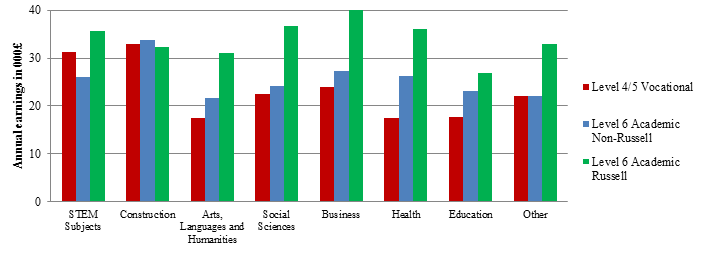Higher vocational education can lead to better earnings than degrees

Post-18 education – who is taking the different routes and how much do they earn?
This paper describes the educational trajectories and labour market outcomes for people who completed their GCSEs between 2002 and 2006. Our long span of longitudinal data enables us to follow these individuals through their schooling and beyond into their early careers.
After finishing compulsory education, young people in England have a range of higher education (HE) and further education (FE) options available to them.
While people are familiar with the route taken by most HE learners – completing A Levels and then a degree at university – less is commonly understood about FE at tertiary level.
In this note, we address this by describing the educational routes taken by individuals who choose to pursue tertiary-level FE courses. Additionally, we show how learners in different post-18 education routes differ by prior attainment, age and gender.
As well as presenting descriptive evidence, we examine the association between different educational pathways and future earnings. Specifically, we present estimates of the early-labourmarket returns (at age 26 and age 30) associated with different levels of post-18 qualifications.
We find that, on average, certain FE qualifications, such as Level 4 qualifications for men and Level 5 qualifications for women, are associated with higher average early-labour-market earnings than completing a degree.
We find that these patterns hold even once we condition on observable characteristics. Whilst we use the term ‘returns’, we are careful not to claim that these estimates capture the causal impact of taking these qualifications, as there may be other factors that we do not observe that may potentially account for selection of different individuals into the different routes.
This note is structured as follows:
- We begin by introducing the data and sample used in our study.
- Next, we present our emerging findings on the different routes taken through post-18 education, as well as the characteristics of learners in different routes.
- Finally, we investigate earnings outcomes for the different post-18 routes and what happens to those earnings outcomes once we condition on observable characteristics of the people taking them.
Key findings
- We describe the educational trajectories and labour market outcomes for people who completed their GCSEs between 2002 and 2006. Our long span of longitudinal data enables us to follow these individuals through their schooling and beyond into their early careers.
- Only around 4% of those with at least a Level 3 qualification by age 19 gain a Level 4, 5 or foundation degree qualification as their highest qualification by age 25. Conversely, almost two-thirds achieve Level 6 as their highest qualification by the same age.
- Foundation degrees are often used as stepping stones to getting degrees. Around half of those who do foundation degrees also complete a degree by age 25. They almost always do so in the same subject.
- Similarly, around one-third of those who obtain Level 4 or Level 5 qualifications also obtain degrees by age 25. For the small number who combine Level 4 and Level 6 qualifications, it is just as common to do the Level 4 qualification after the degree as doing it before.
- People whose highest level of education is Level 4, Level 5 or a foundation degree have much lower prior attainment (as measured by GCSE scores taken at age 16) than people who do degrees.
- Subject choices for sub-degree-level qualifications are very different for men and women. Men are much more likely to be doing engineering & technology; architecture, building & construction (e.g. planning); or computing, while women are more likely to be doing business & administration or nursing. Foundation degrees in creative arts are also quite common.
We estimate ‘returns’ to the different qualification routes. Identifying the causal impact on earnings from taking the different qualification routes is difficult. Taking Level 4 and 5 qualifications was not (and still is not) a typical trajectory for young people, meaning the people we observe taking these routes are likely to be different from people who did not in ways that are difficult to control for (i.e. the estimated returns could be affected by selection bias).
We report our key findings on the earnings outcomes with this caveat very much in mind:
- All higher-level qualifications appear to lead to better earnings outcomes than finishing education at Level 3 for both men and women. Yet there is a great deal of variation in the magnitude of these estimates across the different qualifications taken and by gender.
- For women, completing a Level 5 qualification leads to the highest average return at the age of 26. Female Level 5 achievers (Level 5 only) earn approximately 45.2 log points (57%) more than stopping at Level 3 after adjusting for observable differences between the two groups. This equates to roughly a £9,800 increase in annual earnings at age 26, compared with average earnings of £17,000 from completing education at Level 3.
- For men, Level 4 qualifications lead to the highest average return at the age of 26. On average, these qualifications are associated with earnings at age 26 around £9,000 higher than for men who complete their education at Level 3. This means that male Level 4 achievers (Level 4 only) earn roughly 35.4 log points (42%) more at age 26 than men who complete their education at Level 3, after adjusting for observable differences.
- While the returns to university degrees relative to stopping education at Level 3 appear to be good, it is very notable that they are lower than male Level 4 and female Level 5 estimates. However, the relative earnings differential between these qualifications becomes smaller between the ages of 26 and 30. This, combined with evidence from other sources (e.g. Britton et al. (2020)1 highlighted the large earnings growth of higher education graduates during their 30s) suggests that this gap will be smaller and may indeed reverse at later ages.
- The results are also heavily determined by some specific subject areas. For these reasons, it should not be assumed that massive expansion of sub-degree-level qualifications will yield similar returns to those reported here, especially if in different subject areas.
Earnings of people achieving higher-level vocational qualifications in STEM subjects can exceed those of people who pursued the same subjects at a university level.
3rd Apr 2019: The first comprehensive study comparing the earning outcomes of young people pursuing higher vocational qualifications with those of degree holders was published today by NIESR researchers affiliated with the Centre for Vocational Education Research (CVER).
Analysing data from hundreds of thousands of English secondary school leavers the research finds that by age 30:
- Earnings of degree holders in many subject areas are consistently higher than those of people with higher vocational qualifications.
- However, people achieving Level 4-5 qualifications in STEM (Science, Technology, Engineering and Mathematics) subjects earn more than people with degrees from many universities.
People with higher-level vocational qualifications (i.e. Level 4-5) overall show relatively high earnings early in their working lives because more of them work before or during their studies.
This is very different to degree holders, who are more likely to pursue full-time education up to the end of their studies. Over time, average earnings converge and eventually are higher for degree holders.
However, by the age of 30, those achieving higher vocational qualifications in STEM subjects are observed to have higher average earnings than degree holders in the same broad subject area from Non-Russell Group universities (see Figure 1).
This finding remains consistent when controlling for a wide range of further characteristics.
Figure 1: Median annual earnings* at age 30, KS4 cohort of 2002/03

* in £ at 2015 price levels. Source: Linked education register data for England, cohort of secondary school leavers 2002/03. Acronyms: STEM: Science, Technology, Engineering and Mathematics
NIESR’s Associate Research Director Stefan Speckesser, who co-authored the report said:
“Data on earnings outcomes are extremely valuable as young people and their families approach the choice of higher education. Higher vocational education offers an important – if massively under-explored – alternative choice of tertiary education, often run by local colleges and resulting in lower debt for students compared to those incurred by degree holders (or, if within an apprenticeship, no debt at all because of employer funding).
“Our study shows that for young people interested in specific professional roles, higher vocational education could indeed offer useful, cheaper and ultimately more lucrative alternative to university.”
The study, entitled “A comparison of earnings related to higher level vocational/technical and academic education” was co-authored by Héctor Espinoza and Stefan Speckesser (NIESR and CVER).
About NIESR: Aiming to promote, through quantitative and qualitative research, a deeper understanding of the interaction of economic and social forces that affect people’s lives, and the ways in which policies can improve them.
About The Centre for Vocational Education Research (CVER): A research consortium that aims to generate a step-change in our understanding of the nature, significance and potential contribution of vocational education to individuals and the wider economy.











Responses